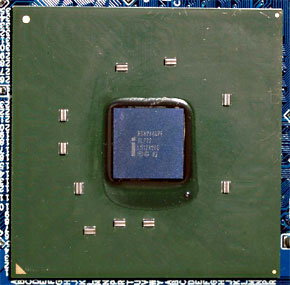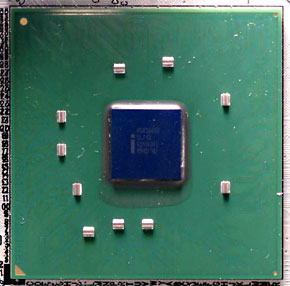 |
||
|
||
| ||
A month after Intel announced the first top Pentium 4 processor of the 800MHz FSB and expensive efficient dual-channel DDR chipset i875P (Canterwood), both technologies started their way into the market. The line of the 800MHz processors extended with the models at 2.4, 2.6 and 2.8 GHz. As usual, if Intel's solutions have equal clock speeds but different bus frequency, cache size or something else, the new models get letters added to the name of the original model; in this case it's "C", which also indicates the Hyper-Threading support. (Multiple traders may not like the new way of giving names since they used the elegant abbreviation of "Pentium 4C" in their price-lists for the Celeron line.) The power supply voltage of a certain sample (any of the three announced models) can make 1.475/1.5/1.525 V depending on the lot (you can get more precise information at the Intel's web site using their special service). The heat generation of the new-comers is much lower than 81.9 W of the 3.0 GHz model and makes 66.2, 69.0 and 69.7 W respectively, and the temperature threshold Tcase is much higher - 74-75°C against 70°C (the processors of the similar clock speeds on the 533MHz bus had the same correlation of these parameters). Intel 865PE/G/P aka SpringdaleA logical step for promoting the new processors (as well as the Hyper-Threading technology) could be development of a relatively inexpensive i865 line (former Springdale) which would possess, as we mentioned in the i875P review, all functions like the top chipset designed for workstations. Just look at the diagram of the i865: 
There are only two fundamental differences: ECC memory and PAT technology
(which theoretically accelerates operation of the i875P). The Canterwood
officially supports only the 533/800MHz FSB, but as we could see from several
boards built on this chipset, the FSB 400 MHz is also supported (including
Celeron processors). There is one more thing to be added regarding compatibility
of the new chipsets with the Pentium 4 and Celeron on the Willamette core.
The chipsets are able to work with them, everything depends on the voltage
regulation module of the VRM processor used on these mainboards. Intel
developed the new VRM specification to ensure compatibility with the future
processors on the Prescott core, but this specification doesn't provide
for the voltage range required for the Willamette. That is why the choice
between the support for the future Prescott (though only the first models,
with the FSB 800 MHz) and the support for Willamette leaving the market
looks quite transparent.

 Here are the brief characteristics of the new chipsets (the details are in the i875P review). Supported:
The two latter devices can work together in the RAID0 mode if the ICH5R south bridge is used. The i865G differs from the i865PE in the integrated graphics core Intel Extreme Graphics 2 (second generation). Because of the under-performance of this video accelerator in heavy-graphics games, we won't describe its architecture. Just note that its core clock speed is 266 MHz, i.e. equal to the i845GE chip, but the i865G has some architectural improvements, and the fast memory should boost the performance in 3D approximately by 50%.  Finally, the i865P is the junior model of the line without the official support of the FSB 800 MHz. Therefore, FSB 533 MHz/2xDDR333 is the maximum for this chipset. Actually, it's possible to arrange support for the 800MHz processors, but, as you will see below, the memory speed can't be changed (DDR400). The new boards will show whether this obstacle can be overcome. PerformanceTestbed:
Software:OS and drivers:
Test applications:
Here are brief characteristics of the boards tested:
Unfortunately, we have data only on the Intel's family. VIA is late with its PT8x0 (the production of the PT800 was to start in May), SiS655FX is not available yet either. We hoped that we could run the Pentium 4 3.0 GHz on the SiS655, but the ASUS P4SDX, the latest board before the announcement, with the latest BIOS version couldn't make the processor work on the 800MHz bus (the maximum working frequency was 196(784) MHz). It looks like that we will have to wait for a new chipset from SiS. Last time we carefully examined different modes of operation of the new/old processors on the new/old chipsets, and this time we are going to compare the i865 chipset family with the current leader i875P. The i865P based board let the tested processor work at 800 MHz of the FSB, that is why the conditions for the competitors are equal. (You can estimate performance of the i865P in its normal conditions in the i875P review.) Test resultsFirst come the low-level memory tests.
In the write and copy speed test the results are uniformly spread from the
i865P to i865PE, and the difference between them makes 17%, with the i865P falling
behind the i875P by 1-2%. In the read test all the 865 models trail the leader
by 10%.
In the archiving the scores agree with the write speed, and the steps are 5-6-8%
from the leader to the outsider.
The final rendering in the 3ds max brings no difference since the CPU's speed
is almost the same.
In the games the models are in the same positions relative to each other, though the gap between the i865PE and i875P shrinks to 3-5%, and the i865G based board comes much closer to its discrete sibling. Although it's useless to compare the integrated graphics of the i865G with the GeForce FX, but in some cases in low resolution it provides an acceptable performance level. And it's questionable whether this accelerator can be used for modern games. ConclusionCanterwood's direct competitor - i865PE - loses 3-5% to it in the real applications, which agrees with Intel's data on the gain from the PAT. Since both chipsets were installed on the fast boards from Gigabyte and Albatron, and the memory timings were minimal (2-2-2-5), we can consider this to be the final result. At the same time, the board on the i865G comes from Intel itself, and models of this company can't boast a high speed. And judging by the maximum timings of 2-3-3-5, the difference between the integrated and discrete versions of the chipset doesn't look strange, that is why this is actually the parity. Finally, the i865P falls too much behind the i865PE to assume it just an accidental difference, and the proper operation at high FSB and memory speeds needs the internal optimization, but the junior model is deprived of it. The i865 family is a good replacement of the i875P since the performance is almost the same and the price of the mainboards must be noticeably lower (the chipset only cuts if off by $15). The functionality is the same except the lack of the ECC support. The advantage over the i845xE is a higher speed, support of the new and future processors and improved south bridge. Certainly you shouldn't dash to replace the old board with the new one, but if you are going to buy one, you should take into account Intel's dual-channel chipsets. That's all.. but what about the ASUSTeK's boards? P.S. Mystery of ASUSLook at the diagrams: Impressed? In defiance of the theory, the ASUS's board on the i875P and i865PE show equal performance and outdo even the i875P by 17% in case of the WinAce archiving. Note that only these boards show so unique results, while the rest go on a par (we tested 6 boards on the i875P from brand-name companies). But the ASUS P4C800 doesn't show such results everywhere: I mean that with the 1002 beta 021 it had the same 11:31 in WinAce. We will try to find out what ASUS did with the memory timings in he
overall comparison of the i875P based mainboards. And now we decided to
use "normal" boards, otherwise the difference between, say, i865PE and
i865G can become too great.
Write a comment below. No registration needed!
|
Platform · Video · Multimedia · Mobile · Other || About us & Privacy policy · Twitter · Facebook Copyright © Byrds Research & Publishing, Ltd., 1997–2011. All rights reserved. | |||||||||||||||||||||||||||||||||||||||||||||||||||||||||||||||||||||||||||||||||||||||||||||||||||||||||||||||||||||||||||||